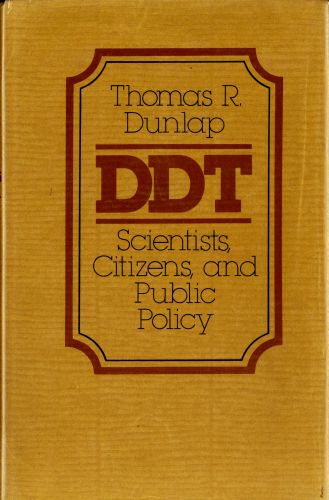

| DDT Scientists, Citizens, and Public Policy Thomas R. Dunlap Princeton: Princeton University Press, June 1981 |
Rating: 5.0 High |
|||
| ISBN-13 978-0-691-04680-8 | ||||
| ISBN 0-691-04680-8 | 318pp. | HC/GSI | $25.95 | |
The book that is credited by many with igniting the ecology movement, Silent Spring by wildlife biologist Rachel Carson, was first published in September 1962. Thus we are coming up on the fiftieth anniversary of this book. You might think there would be little to say about Carson's work after so long; but such is not the case. Certain pesticide advocates continue to cast doubt on her findings, and those who deny the mainstream consensus on climate science are often still more strident, accusing the ban on DDT that they claim resulted from her book of causing the malaria deaths of millions.
The reality, however, is somewhat more complex. This book by Thomas Dunlap is one reference that sets the record straight. It does more, in fact: It places the DDT controversy in the context of the times.
"This monograph, an attempt to place the controversy over DDT in historical perspective, grew out of the author's conviction that this period was not merely startling but significant, that a history of the involvement of scientists and citizens in the making of policy on this issue could shed light on the social history of science in modern America. It is not simply that the consequences of DDT use are still with us in the form of residues in fat and breast milk, or that the kind of environmental contamination found in the one case has been confirmed for other chemicals. Both of these are valid reasons for an assessment of the controversy, for an effort to place it in the context of modern America. But the confrontation also brings to light the complex relationships among government agencies, the land-grant universities and their associated experiment stations, private industries, and the various sciences. It can tell us something about the nature of American support for science and the ways in which the social, economic, and political contexts in which scientists worked affected both the research they did and the ways in which their knowledge was or was not used in making policy." – Page 3 |
Dunlap is correct. By alerting the American public to the potential dangers of DDT and other pesticides, Rachel Carson set the stage for a radical shift in the way science and technology were viewed by the American public. Previous to 1945, science and its technological products were considered impeccable — unalloyed assets in the march of human progress. Of course like any tool they could be misused — World War 2 was proof of that — but the tools themselves were not at fault. That began to change with the radioactive fallout from atomic bomb tests after the war, and with the rapid deployment of persistent pesticides like DDT, aldrin and dieldrin.
But Silent Spring did not bring about this transformation all on its own. With respect to DDT, in fact, evidence of harm began accumulating well before its publication. During the late 1950s, with DDT being sprayed in towns and cities throughout the eastern U.S., and especially with three massive eradication campaigns by the Department of Agriculture, aimed at the insect vector of Dutch elm disease, the gypsy moth in the northeast, and the fire ant1 in the south, citizens and hunters began to notice the disappearance of birds and fish. Field research soon confirmed these losses, and wildlife biologists began a search for the causes.
"By February 1946 two government biologists, Clarence Cottam and Elmer Higgins, could point to studies done in twelve states and Canada showing the dangers of DDT and the ways to minimize damage to the environment. Heavy or carelessly applied sprays, they warned, caused extensive mortality among fish and birds. For example, two investigators had found that a single application of DDT to a Pennsylvania forest at the rate of five pounds per acre 'resulted in the death of birds and a conspicuous reduction in the breeding population.' The use of DDT should therefore be restricted to the control of serious pests, they said. When it was necessary, it should be used with caution and under conditions that would minimize danger to wildlife. The smallest possible doses should always be used, sprays never applied to bodies of water, and strips left unsprayed in wildlife refuges." – Page 77 |
In DDT, Dunlap has performed a valuable service. He presents the development of DDT, far superior to the arsenate insecticides it replaced, a godsend to American troops during the Italian campaign of World War 2, and a boon to third-world populations beset by malaria and other vector-borne diseases — but a genuine threat to human and animal populations worldwide, not only when misuse led to massive overexposures, but when applications as dilute as 14 ppb were concentrated in apex predators such as the peregrine falcon and the bald eagle, causing failure to reproduce. The book provides abundant documentation of these findings, and I have summarized a selection of them in a table on a page linked below.
My present concern is just the effects of DDT on wildlife, which led to its being banned in the U.S. in 1972. I therefore have not read the entire book; but I feel that reading just chapters 4 and 5, and the beginning of 6, give me enough basis for a fair assessment. That is that this book deserves top marks and is a definite keeper. I feel that nowhere outside of a collection of scientific papers is there so complete a collection of findings on the effects of DDT. As well, the book records a detailed chronology of the legal and legislative battles over pesticide safety. It is a treasure trove in both respects.

 To contact Chris Winter, send email to this address.
To contact Chris Winter, send email to this address.